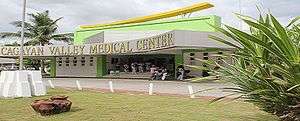Tuguegarao
| Tuguegarao | ||
|---|---|---|
| Component City | ||
| Tuguegarao City | ||
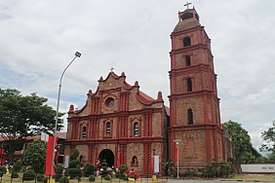 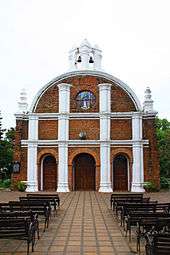  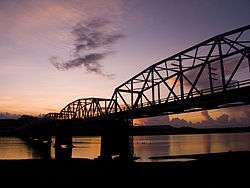  From top, clockwise: St. Peter Metropolitan Cathedral Parish; ruins of the horno (kiln) in Barangay Bagumbayan; SM Center Tuguegarao Downtown, the first SM mall in Cagayan; Buntun Bridge, the country's longest river bridge; Ermita de Piedra de San Jacinto (Stone Chapel of St. Hyacinth) | ||
| ||
|
Nickname(s): The Premier Ibanag City[1][2] Gateway to Ilocandia and the Cordilleras[3] | ||
| Anthem: "Tuguegarao City Hymn" | ||
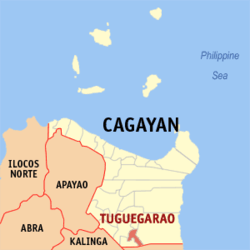 Map of Cagayan showing the location of Tuguegarao | ||
.svg.png) Tuguegarao Location within the Philippines | ||
| Coordinates: 17°37′N 121°43′E / 17.62°N 121.72°ECoordinates: 17°37′N 121°43′E / 17.62°N 121.72°E | ||
| Country | Philippines | |
| Region | Cagayan Valley (Region II) | |
| Province | Cagayan | |
| District | 3rd District of Cagayan | |
| Founded | May 9, 1604 | |
| Patronal Feast Day | August 16 | |
| Cityhood | December 18, 1999 | |
| Barangays | 49 | |
| Government[4] | ||
| • Type | Mayor–council | |
| • Mayor | Jefferson P. Soriano | |
| • Vice Mayor | Bienvenido de Guzman, II | |
| • City Council |
Councilors
| |
| Area[5] | ||
| • Total | 144.80 km2 (55.91 sq mi) | |
| Area rank | 83rd of 145 cities | |
| Population (2015)[6] | ||
| • Total | 153,502 | |
| • Density | 1,100/km2 (2,700/sq mi) | |
| Demonym(s) |
Tuguegaraoeño (masculine) Tuguegararoeña (feminine) | |
| Time zone | UTC+8 (PST) | |
| ZIP code | 3500 | |
| IDD : area code | +63 (0)78 | |
| Income class | 3rd class | |
| Revenue | ₱707,365,303.60 (2016)[7] | |
| Website |
www | |
Tuguegarao, officially Tuguegarao City (Ibanag: Siudad nat Tuguegarao; Itawit: Siudad yo Tuguegarao; Ilokano: Siudad ti Tuguegarao; Filipino: Lungsod ng Tuguegarao [tʊgɛ̝gäˈɾɐw]) and referred to by locals as Tugue, is a 3rd-class component city in the Philippines. It is the capital of the province of Cagayan and the regional and institutional center of Cagayan Valley Region. With a population of 153,502,[6] it is a major urban center in the Northeastern Luzon, a primary growth center and one of the fastest growing cities in the Philippines.
Dubbed as the “Gateway to the Ilocandia and the Cordilleras,”[3] the city, on the southern border of the province, is located where the Pinacanauan River empties into the Cagayan River and is surrounded by the Sierra Madre Mountains to the east, Cordillera Mountains to the west, and the Caraballo Mountains to the south.
The highest temperature ever recorded in the Philippines—42.2 °C (108.0 °F)—was recorded in Tuguegarao on April 29, 1912 and again on May 11, 1969.[8] The average temperature during March and April is 38 °C (100 °F),[9][10] one of the highest in the country.
Etymology
There are several legends about the origin of the name of the city of Tuguegarao. One is the abundance of a species of palm tree called taraw in the area. Another recorded version is that the town was formerly called Tuerao by the people of the northern towns. Another states that the name Tuguegarao comes from two Ibanag words tuggi (fire) and aggao (day), possibly referring to a daytime fire that happened in the town.
The most accepted version of the legend is the Ibanags' reply to the Spaniards when the latter asked for the name of the place — Tuggi gari yaw ("this was cleared by fire"),[11] or the town was carved out of the wilderness by clearing and burning.
On the other hand, historical evidence that might provide clues to the origin of the city's name comes from the fact that in 1591, the place was listed as a Spanish encomienda, which was originally a pre-colonial settlement called Tubigarao.[12]
History

The community was governed as a barangay established by the Dominicans as a mission until the Spaniards gave it the status of pueblo (municipality) on May 9, 1604, making it one of the political units of the province of Cagayan. The settlement was small in terms of population but was large in territory, which then included what would later become the provinces of Isabela, Nueva Vizcaya and Quirino until the 1850s. As a mission pueblo and with assigned encomendero (landlord) to Tuguegarao, the inhabitants (as tenants) were made to pay taxes in the form of poultry and other food products. Resentments later flared and the people of Tuguegarao revolted in 1605, killing the encomendero. Again, the people of Tuguegarao revolted in 1718 and then 1761 under a leader named Rivera.
The first parochial building of Tugugarao was constructed in 1604, a chapel that became the foundation of what is now the Ermita de Piedra de San Jacinto (Stone Chapel of Saint Hyacinth), dedicated to Saint Hyacinth, the patron saint of Tuguegarao. The present chapel is the latest in a process of rebuilding that started in 1724 when it was rebuilt by Fr. Bernabe de la Magdalena, O.P.
Tuguegarao became the capital of Cagayan province in 1839 when the provincial seat of power was relocated from Lal-lo. The decline of Lal-lo became the transformation of Tuguegarao as the most important town in Cagayan.
The formative period of Tuguegarao was marked by its immense development on education. Don Vicente Nepomuceno ventured to open a school in the later part of 1896. Don Ricardo Tuyuan and Don Vicente Pagalilauan were the first instructors. Subjects primarily taught were Spanish grammar, Latin, Greek, geography and mathematics.[11]
In 1907, the Dominicans opened Colegio Sagrado Corazon de Jesus which was run by the French Religious Sisters of St. Paul of Chartres. A public school was also built during the term of municipal president Esteban Quinto. After further investment in educational institutions, Cagayanos reverted their interest to journalism. As a result, various publications rose and have been considered reputable, such as El Porvenir, Don Pablo Salo's Noticiero, Don Honorio Lasam's El Voz del Pueblo or La Verdad, and Don Nicanor's Sinceridad.[11]
World War II
Tuguegarao was occupied by American troops on December 12, 1899. Drastic improvements in Tuguegarao were discerned over the course of provincial administrations—the first Provincial Capitol was completed in 1909, the town hall and public market were built, the municipal board purchased the residence of George Weber to house the provincial high school, the Cagayan Trade School was founded by American educator Claude Andrews and construction of the Cagayan High School building, completed in 1923.[11]
During World War II, the city and its airfield of some significance was captured by the Japanese Imperial Army on December 12, 1941 as part of the Japanese invasion of Aparri. The General Headquarters of the Philippine Commonwealth Army, Philippine Constabulary and the USAFIP-NL units was activated on 1942 to 1946 and stationed in Tuguegarao.
On December 8, 1944, Tuguegarao was bombed as Japanese forces entered Luzon. The provincial government was immediately transferred to Tuao on December 10, 1944. The Japanese Imperial Army occupied Tuguegarao on December 12.[11] The town and airfield were bombed by the US and Philippines regularly between January and May 1945, and attacked by Donald Blackburn's guerrilla forces in June 1945.[13]:299–302 The town was reduced to complete rubble, including the Cathedral. The local recognized guerrillas helped by entering the town, Philippine Commonwealth troops under the Philippine Army and Constabulary units and USAFIP-NL military units came in early June; the town was officially liberated on June 25, 1945.
Provincial and regional capital
Tuguegarao was once the only first-class municipality in the province of Cagayan. It has served as the provincial capital of Cagayan since 1839 because of the notable socio-economic progress of the town.
After independence, President Manuel Roxas appointed Engineer Peregrino Quinto as governor of Cagayan. In the 1947 elections, Attorney Nicasio Arranz was elected governor and Dr. Venancio del Rosario, Sr. as mayor of Tuguegarao. On April 9, 1949, Tuguegarao hosted the Philippine Interscholastic Athletic Meet, the predecessor to the Palarong Pambansa, which was officially opened by President Elpidio Quirino. The provincial capitol at Alimannao was constructed under the administration of Governor Nicasio Arranz and the provincial offices transferred to the new building in 1954 at the beginning of the administration of Governor Jose P. Carag.[11]
Sitio Capatan was elevated into a barrio (or barangay) of Tuguegarao on April 3, 1959, by Republic Act no. 2107.[14]
In 1975, Tuguegarao was declared as the capital and seat of the regional government of Cagayan Valley (Region II) being the region's geographic center with adequate facilities and amenities needed by such.
New barangays were formed in the 1970s that by 1981, Tuguegarao had 49 barangays, 12 of which were urban. The late 1980s saw the gradual expansion of the urban core of Tuguegarao to the outlying barangays of Ugac, Caritan and Atulayan. With the fast rising prices of real estate in the poblacion (city center), residents found it profitable to sell their properties in the poblacion and buy lots in the surrounding barangay neighborhoods, but still close to avail the amenities of the city.
By 1980, Tuguegarao had a population of 73,507. The increase in population could be attributed to various factors. One is the increasing peace and order problems in the other towns in the region driving the people to Tuguegarao, which is relatively free of the insurgency problem with the visible presence of the military and its geographic location. Another factor is the presence of the schools, whose quality of education is highly comparable to that of Metropolitan Manila. Others come because of the increase in trade and industry. The completion of the Maharlika Highway made Region II more accessible to people from other areas.
1983 marked the quadricentennial celebration of the establishment of the civil government of the Province of Cagayan. In the week-long celebration held in Tuguegarao, several Philippine cabinet ministers visited the town and province.
The town has seen tremendous improvements in social services and infrastructure facilities since 1975. Multistory buildings were constructed in the poblacion greatly changing Tuguegarao's skyline in the 80s and 90s. Other changes included landscaped schools and homes, cable television, air-conditioned buses, jet flights, telegraph and telex services, door-to-door delivery services, domestic and overseas long-distance calls, luxurious social amenities and other trappings of a highly urbanized town.
Cityhood
Tuguegarao became a component city after it was affirmed in a plebiscite held on December 18, 1999. Randolph Sera Ting is the first mayor of the new city. On July 2, 2007, Delfin Telan Ting (who was then a municipal mayor from 1988 to 1998) was elected to become the second mayor of the city. After the 25-year political domination of the Tings, former police general Jefferson Soriano won over re-electionist Delfin Ting in the 2013 local elections.[15]
Hotel Delfino siege
The Hotel Delfino siege was a bloody coup attempt that happened on March 4, 1990, when suspended Cagayan governor Rodolfo "Agi" Aguinaldo and his armed men of 200 seized Hotel Delfino in Tuguegarao. Brigader General Oscar Florendo, his driver, four members of the civilian staff, and several other people were held hostage for several hours. A gunfight was launched to kill Aguinaldo and his men but one of the suspended governor's men was found dead in a checkpoint shootout, Brig. Gen. Florendo and 12 others were also dead and 10 more wounded. Aguinaldo was slightly wounded in a car gunfight but eventually escaped and hid in the mountains.
Geography
Tuguegarao's location is in the southern portion of the province. The city is bordered by Iguig to the north; to the west by the Cagayan River alongside Solana; Peñablanca to the east; and to the south by Enrile and San Pablo, Isabela. The city is almost encapsulated by the Cagayan River in the western and southern side, which explains for its northward expansion, and the Pinacanauan River, a tributary of Cagayan River, in the eastern part. Small bodies of waters are found in the city, such as the Balzain Creek which spans the barangays of Caritan Sur and Balzain. Currently, the creek is continuously drying up due to eutrophication and the uncontrollable growth of water lilies.
Historically, the town was inhabited by Irayas and Itawes who lived and mainly relied on fishing, farming, hunting and livestock raising. In addition, ancient natives have ventured on weaving cloth and making of household and farm implements.[16]
Cagayan is divided into three congressional districts, wherein the city is included in the Third District together with the other 6 southern municipalities.[17]
The city is 483 kilometres (300 mi) north of the country's capital, Manila, which is an hour by plane and ten hours of land travel.[17]
Barangays
The city is politically subdivided into 49 barangays. 31 of these barangays have been classified by the city as urban.[18] Most of the rural barangays have agricultural territories, although some of the urbanized ones have mixed commercial, residential, and agricultural sites.
| Barangay | Classification | Population (2015) |
|---|---|---|
| Annafunan East | Urban | 4,207 |
| Annafunan West | Urban | 3,310 |
| Atulayan Norte | Urban | 3,578 |
| Atulayan Sur | Urban | 4,404 |
| Bagay | Rural | 3,393 |
| Buntun | Urban | 4,373 |
| Caggay | Urban | 7,261 |
| Capatan | Rural | 3,337 |
| Carig Norte | Rural | 2,267 |
| Carig Sur | Urban | 4,536 |
| Caritan Centro | Urban | 4,872 |
| Caritan Norte | Urban | 3,093 |
| Caritan Sur | Urban | 1,833 |
| Cataggaman Nuevo | Urban | 8,161 |
| Cataggaman Pardo | Rural | 3,292 |
| Cataggaman Viejo | Rural | 4,246 |
| Centro 01 (Bagumbayan) | Urban | 1,158 |
| Centro 02 | Urban | 553 |
| Centro 03 | Urban | 339 |
| Centro 04 | Urban | 566 |
| Centro 05 | Urban | 1,126 |
| Centro 06 | Urban | 195 |
| Centro 07 | Urban | 262 |
| Centro 08 | Urban | 125 |
| Centro 09 | Urban | 969 |
| Centro 10 (Riverside) | Urban | 2,282 |
| Centro 11 (Balzain East) | Urban | 2,990 |
| Centro 12 (Balzain West) | Urban | 2,391 |
| Dadda | Rural | 1,167 |
| Gosi Norte | Rural | 1,016 |
| Gosi Sur | Rural | 1,297 |
| Larion Alto | Rural | 1,856 |
| Larion Bajo | Rural | 2,345 |
| Leonarda | Urban | 2,503 |
| Libag Norte | Urban | 2,384 |
| Libag Sur | Urban | 2,708 |
| Linao East | Rural | 6,939 |
| Linao Norte | Rural | 3,005 |
| Linao West | Rural | 1,665 |
| Namabbalan Norte | Rural | 1,433 |
| Namabbalan Sur | Rural | 746 |
| Pallua Norte | Rural | 2,450 |
| Pallua Sur | Rural | 2,683 |
| Pengue-Ruyu | Urban | 5,629 |
| San Gabriel | Urban | 6,828 |
| Tagga | Rural | 1,346 |
| Tanza | Urban | 5,665 |
| Ugac Norte | Urban | 9,615 |
| Ugac Sur | Urban | 10,858 |
| TOTAL | 153,502 | |
Climate
Tuguegarao experiences a tropical climate, with only a slight difference between summer and winter temperatures, and high year-round humidity.
On April 29, 1912 and May 11, 1969, the highest temperature in the Philippines was recorded in Tuguegarao at 42.2 °C (108.0 °F).[8] Thus, the city was tagged as the "Hottest City in the Philippines".
| Climate data for Tuguegarao | |||||||||||||
|---|---|---|---|---|---|---|---|---|---|---|---|---|---|
| Month | Jan | Feb | Mar | Apr | May | Jun | Jul | Aug | Sep | Oct | Nov | Dec | Year |
| Record high °C (°F) | 37 (99) |
37 (99) |
40 (104) |
42 (108) |
41 (106) |
41 (106) |
41 (106) |
38 (100) |
37 (99) |
38 (100) |
36 (97) |
38 (100) |
42 (108) |
| Average high °C (°F) | 28 (82) |
30 (86) |
33 (91) |
36 (97) |
36 (97) |
36 (97) |
34 (93) |
34 (93) |
33 (91) |
31 (88) |
30 (86) |
28 (82) |
32 (90) |
| Daily mean °C (°F) | 23 (73) |
24 (75) |
26 (79) |
29 (84) |
29 (84) |
29 (84) |
28 (82) |
28 (82) |
27 (81) |
26 (79) |
25 (77) |
24 (75) |
27 (80) |
| Average low °C (°F) | 19 (66) |
18 (64) |
20 (68) |
22 (72) |
23 (73) |
23 (73) |
22 (72) |
22 (72) |
22 (72) |
22 (72) |
21 (70) |
20 (68) |
21 (70) |
| Record low °C (°F) | 12 (54) |
13 (55) |
14 (57) |
17 (63) |
17 (63) |
18 (64) |
18 (64) |
19 (66) |
18 (64) |
18 (64) |
12 (54) |
12 (54) |
12 (54) |
| Average rainfall mm (inches) | 31.2 (1.228) |
23.0 (0.906) |
27.7 (1.091) |
28.1 (1.106) |
113.5 (4.469) |
141.4 (5.567) |
176.4 (6.945) |
236.6 (9.315) |
224.9 (8.854) |
247.7 (9.752) |
222.9 (8.776) |
178.0 (7.008) |
1,651.4 (65.017) |
| Average rainy days | 10 | 6 | 5 | 5 | 13 | 12 | 15 | 15 | 15 | 17 | 16 | 15 | 144 |
| Average relative humidity (%) | 82 | 76 | 73 | 71 | 72 | 75 | 79 | 79 | 80 | 82 | 84 | 85 | 78 |
| Source #1: World Weather Online[19] | |||||||||||||
| Source #2: Weatherbase[20] | |||||||||||||
Demographics
In the 2015 census, the population of Tuguegarao was 153,502 people[6] with a density of 1,100 inhabitants per square kilometre or 2,800 inhabitants per square mile. It is the most populous and densest city in the Cagayan Valley region. Most of the inhabitants are Ilocanos, Ibanags and Itawes. Some are of Chinese and Indian descent.
| Population census of Tuguegarao | ||
|---|---|---|
| Year | Pop. | ±% p.a. |
| 1903 | 16,105 | — |
| 1918 | 19,298 | +1.21% |
| 1939 | 27,643 | +1.73% |
| 1948 | 29,083 | +0.57% |
| 1960 | 43,074 | +3.33% |
| 1970 | 56,956 | +2.83% |
| 1975 | 62,513 | +1.88% |
| 1980 | 73,507 | +3.29% |
| 1990 | 94,787 | +2.58% |
| 1995 | 107,275 | +2.35% |
| 2000 | 120,645 | +2.55% |
| 2007 | 129,539 | +0.99% |
| 2010 | 138,865 | +2.56% |
| 2015 | 153,502 | +1.93% |
| Source: Philippine Statistics Authority[6][21][22][23] | ||
Economy
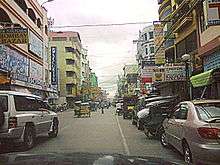
Within the past three decades, Tuguegarao's economy gradually shifted from agriculture to secondary and tertiary economic activities such as trading, commerce and services. The shift was ushered by Tuguegarao's role as the provincial and regional government center and one of the centers of commerce in Northern Luzon. Banking, educational, commercial, industrial and tourism-related activities proliferate in the area.
As of 2013, there were 4,210 registered business establishments for which more than half are located in the Poblacion and less than one third are in the urban barangays. Of these registered establishments, 53.48% are wholesale and retail trade establishments. Financing, insurance and real estate firms contributed 8.54%, and the remaining 37.98% consist of service enterprises and social amenities to include business, recreational, personal, utility and other services. At present, there are 43 banks operating in the city.

In early 2016, Tuguegarao City was named as one of the ten emerging cities in the 2015 Next Wave Cities report, conducted by Department of Science and Technology - Information and Communications Technology Office (DOST-ICTO).
Retail
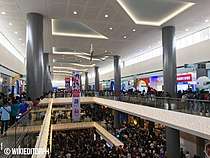
Large retail operators have shown significant to the growth and increase of land value in cities throughout the Philippines. They are seen as highly developed urban centers where a lot of economic activities take place, and is important to urbanization and development. Tuguegarao is eyed as a center of exponential growth for commerce, industry and service, strengthening its stature as the capital of the Cagayan Valley Region. Around 2017, The country's largest mall operators have procured the construction of retail hubs spread throughout the city proper.
SM Prime, the largest retail operator in the country, strengthened its presence as it opened SM Center Tuguegarao Downtown on October 12, 2017. It was their first mall in Cagayan and the second in Cagayan Valley. Plans have also been made for the construction of another SM mall in Tuguegarao in 2019.[24]
Rival retailers also plan to set up their own retail centers in the city. Robinsons Land Corporation opened its first mall in the province and the second in the region, the Robinsons Place Tuguegarao on July 26, 2018 located along Maharlika Highway in Barangay Tanza.[25][26] DoubleDragon Properties also plans to set up CityMall Tuguegarao along the same road adjacent to the Tuguegarao Airport area.
Education


Due to its high incidence of universities, Tuguegarao has been dubbed as an Educational Powerhouse of the Northern Philippines. It is home to several international schools, such as St. Paul University Philippines and the University of Saint Louis.
Two of the top state universities are also in Tuguegarao City — the CSU Athena (Andrews Campus), and CSU Red Eagle (Carig Campus). Both universities have their own administration and are separated from each other.
Other schools in the city include the University of Cagayan Valley, John Wesley College, F.L. Vargas College, Maila Rosario College, Credo Domine College, City Technological Institute, Cagayan Metropolitan Institute of Technology, STI College, AMA Computer College, and many other minor educational institutions.
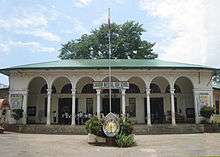
The Technical Education and Skills Development Authority (TESDA) was established through the enactment of "Technical Education and Skills Development Act of 1994", which was signed into law by President Fidel V. Ramos. This Act aims to encourage the full participation of and mobilize the industry, labor, local government units, and technical-vocational institutions in the skills development of the country's human resource. The TESDA complex and facilities are located at Brgy. Carig Norte, Tuguegarao.
Tuguegarao has one Jesuit educational institution located along Bagay Road—the Global Reformed University.
Other notable schools in the city include Cagayan National High School, the oldest and biggest secondary school in the region in terms of student population, Tuguegarao City Science High School, a state-owned secondary institution, Ke Bing School, a private Chinese school, Methodist Christian School, a Christian school in Central Business District, and Saint Claire Montesorri, a catholic school in San Gabriel. The state-owned secondary institution of Tuguegarao City West High School started operations on June 4, 2012.
Healthcare
Being the regional center, Tuguegarao hosts major hospitals which serve people in the Cagayan Valley region. Cagayan Valley Medical Center, the largest medical facility in the Cagayan Valley with a bed capacity of 500, is situated in the city. The largest privately owned facility in the region is the 250-bed Dr. Ronald P. Guzman Medical Center, a tertiary level hospital.[27] St. Paul University Philippines has an affiliate hospital in Tuguegarao, the St. Paul Hospital. Cagayan's oldest existing private hospital, the Dr. Domingo S. De Leon General Hospital, formerly Clinica De Leon, is also situated in the city.
Other hospitals in the city are the government-owned and run Tuguegarao City People's General Hospital and the Holy Infant Hospital[27] as well as the privately owned Divine Mercy Wellness Center.[28]
Culture

The Afi Festival is an annual festival every August, celebrated in commemoration of the city's patron saint, San Jacinto de Polonia whose feast day falls on August 16.[29] It came from the Ybanag word afi, meaning fire.[30]
The concept of the "Afi" started in 2014, renaming the former Pav-vurulun Festival. It reiterates and reaffirms the origins of the city's name. Stories say the place where the city center now stands was once “a wilderness that was cleared by fire” through kaingin (slash and burn farming).[29] The main event of the celebration is its opening day, where thousands of students convene for a field demonstration at night as torchbearers. In 2017, 3500 students from Cagayan National High School and Cagayan State University - College of Human Kinetics danced with torches at the sports complex. The city is attempting to beat Indonesia's world record of 3,777 torchbearers in the festival's next edition.[31]
Other highlights of the weeklong celebration include the street dancing competition and drum and lyre competition, where various elementary and secondary schools participate, everyone clad in vibrant costumes and props. Both are usually held at the city's central business district on Bonifacio Street (Calle Commercio). Other events include the Bangkarera competition, a rowing competition in two categories which aims to promote sustainable fishing along the Pinacanauan River, which flows to the Cagayan River, a pansit festival featuring a pansit-eating contest, a Nuang Karera (Carabao race), a Kabayu Karera (horse race), among others.[32]
Before the additions and revisions to the native festival, there was Maskota Festival. Also called the Dance of Lovemaking, it features Maskota, a wedding dance prevalent in the provinces of Cagayan and Isabela, with movements described as "spontaneous, lively and extravagantly expressive." It was danced to the rhythm of the verso with the sincosinco accompaniment. Back then, indigenous materials were utilized for the costumes. Materials come from various local harvests such as coconut sprouts, betel nuts, corn leaves and atchuetes, which serves as natural coloring.[33]
Local government
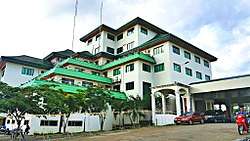
Tuguegarao City is governed by a city mayor, designated as local chief executive, and by a city council, composed of the vice mayor and the city councilors, as the legislative body, in accordance with the Local Government Code.[34] They are voted to office through an election, held every after three years.
As a component city, the provincial government of Cagayan has political jurisdiction over local transactions of the city government.
| Position | Name |
|---|---|
| City Mayor | Atty. Jefferson P. Soriano (NPC) |
| City Vice Mayor | Bienvenido C. De Guzman II (NPC) |
| City Councilors[35] | Danilo L. Baccay (NPC) |
| Jude T. Bayona (NPC) | |
| Kendrick S. Calubaquib (NPC) | |
| Maila S. Ting-Que (NUP) | |
| Arnel T. Arugay (NPC) | |
| Winnoco R. Abraham (NP) | |
| Gilbert S. Labang (NPC) | |
| Imogen Claire M. Callangan (NPC) | |
| Atty. Marjorie P. Martin-Chan (LP) | |
| Atty. Raymund P. Guzman (LP) | |
| Grace B. Arago (NPC) | |
| Anthony C. Tuddao (NPC) | |
A series of events resulted in changes in the elected officials. Last February 10, 2017, then City Mayor Atty. Jefferson P. Soriano stepped down from office following an order from the Ombudsman to dismiss him for grave misconduct. Soriano voluntarily called the Department of Interior and Local Government (DILG) to facilitate the turn over of the mayoralty office to then Vice Mayor Bienvenido de Guzman II.[36] Roughly after seven months, following the order of the Court of Appeals Fourth Division (CA) for "immediate" reinstatement of Mayor Jefferson P. Soriano, on September 6, 2017, Soriano took oath of office. The CA disagreed to the Ombudsman's dismissal order—stating that he committed grave misconduct—and that the mayor only committed simple misconduct. According to the decision, he should only be penalized with three months suspension instead of dismissal from service.[37]
Transportation
Transportation and infrastructure plays a major role in keeping the Tuguegarao's economy up and running and nearby towns in play. Due to continued growth, daytime population in the city has increased with primary reasons for commuting for commerce, work and notably education due to the city's being known for having several institutions. Over the years, Tuguegarao evolved, expanded and grew, so did its transportation network to keep up with the growing demands of people for ease of access to reliable methods and transit flexibility.
Road transport
Public transport
A cultural icon of the Philippines with a unique design, Tuguegarao's tricycles offer shared vehicle for hire services for small groups of passengers on a common route over short distances.
Tuguegarao also serves as a vital hub for local, regional and national transportation. Buses operate regional routes from Tuguegarao to Baggao, Aparri, Santiago, and many neighboring cities, towns and municipalities. It also is a end-of-the-line stop for many coaches running inter-city and national routes mostly coming from Metro Manila.
To the east side are vans that ply north and south Claveria, Santa Praxedes, Aparri, Santa Ana, Alcala, Lasam and Junction Luna, Abulug in Cagayan, Santiago, Roxas, Ilagan and Cauayan in Isabela, Luna and Kabugao in Apayao. There are also mini buses plying to Lasam, Allacapan, Claveria, Santiago and Roxas. Then to the west are jeepneys with routes to Iguig, Tuao, Enrile, Tabuk and Rizal in Kalinga and some mountainous barrios, all of which lie on the west side of the river.
Kalesas run within the city, mostly near popular points of interest, and are part of the city's tourism.
Main roads
Regional transport in Tuguegarao is vulnerable given its lack of distribution of arterial roads and inadequate traffic engineering planning and discipline.
- The Buntun Highway-Luna Street network is a major 4-lane road network of Tuguegarao that forms part of the National Route 51 (N51). It is the only road that serves west-side traffic to Tuguegarao. It links Tuguegarao to the western side of the Cagayan River via the Buntun Bridge, further towns from the west side most notably the municipalities of Solana and Enrile, the Philippine highway network and the Santiago-Tuguegarao Road.
- The Balzain Highway-Cagayan Valley Road is another major 4-lane road network of Tuguegarao, part of Cagayan Valley Road that comes through Balzain and Carig, that forms part of the Asian Highway 26 (

Air
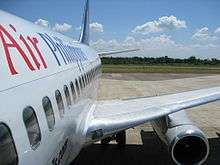
The Tuguegarao Airport handles domestic flights within the Philippines and serves the general area of Tuguegarao and its surrounding municipalities, and is capable of handling Boeing-737-sized aircraft. It is the 23rd busiest airport in the country as of 2017 statistics. Classified by the Civil Aviation Authority of the Philippines as a Principal Class 1 domestic airport, small aircraft, helicopters and army cargo aircraft also utilize the airport. Cebu Pacific, Sky Pasada and PAL Express are the domestic airlines which operate routes to and from the city. As of 2017, the airport is undergoing rehabilitation and expansion consisting of terminal upgrades and widening of runway, for night landing capabilities, and taxiway. The upgrades cost ₱56.65 million which are part of the Tuguegarao Airport Development Project by the Department of Transportation and Communications.[38]
A proposed international airport, serving the Cagayan Valley Region, will be constructed at the eastern portion of the city—somewhere in barangays Dadda or Tagga—as suggested by City Mayor Bienvenido de Guzman II and former mayor Atty. Jefferson Soriano. Originally, as proposed by the Cagayan Governor Manuel Mamba, the airport was to be located at the tri-boundary area of Tuao, Piat and Solana towns but was later shelved after a forum.[39]
Notable people
- Rommel Adducul, former professional basketball player and coach
- Ricardo Baccay, bishop of the Diocese of Alaminos
- Eulogio Balao, former soldier and politician
- Philip Butel, Caloocan Supremos basketball player
- Rachelle Anne Cabral, archer in the 2012 Summer Olympics
- Noel A. Coballes, retired Lieutenant General and Commanding General of the Philippine Army (2013-2014)
- Ralph Guzman, broadcaster and journalist
- Benito Antonio T. de Leon, retired AFP military officer
References
- ↑ http://www.oocities.org/mytugcity/childfriendly.html
- ↑ http://ibanagcity.blogspot.com/2008/08/tuguegarao-city-premier-ibanag-city.html
- 1 2 http://www.rdc2.gov.ph/invest/tuguegarao/index.php/basicfacts/reasons-to-invest
- ↑ "Official City/Municipal 2013 Election Results". Intramuros, Manila, Philippines: Commission on Elections (COMELEC). 11 September 2013. Retrieved 30 January 2014.
- ↑ "Province: CAGAYAN". PSGC Interactive. Makati City, Philippines: National Statistical Coordination Board. Archived from the original on 2 February 2014. Retrieved 30 January 2014.
- 1 2 3 4 Census of Population (2015). "Region II (Cagayan Valley)". Total Population by Province, City, Municipality and Barangay. PSA. Retrieved 20 June 2016.
- ↑ "Cities and Municipalities Competitiveness Index - Cagayan Province". National Competitiveness Council, Philippines.
- 1 2 (2013-04-04). "PAGASA: Hottest day so far this year in NCR at 35.2 degrees Celsius". GMA News Online. Retrieved on 2013-08-02.
- ↑ "March Climate History for Tuguegarao". myweather2.com.
- ↑ "April Climate History for Tuguegarao". myweather2.com.
- 1 2 3 4 5 6 "History". Tuguegarao City Official Website.
- ↑ Taken from the city's official website as written by Maria Fe B. Agu-Villania, CPA, CSEE, the City's Planning and Development Coordinator
- ↑ Harkins, P., 1956, Blackburn's Headhunters, London: Cassell & Co. LTD
- ↑ "An Act Creating the Barrio of Capatan in the Municipality of Tuguegarao, Province of Cagayan". LawPH.com. Retrieved 2011-04-13.
- ↑ Lagasca, Charlie. "Tuguegarao City, a Ting stronghold, has new mayor". philstar.com. The Philippine Star.
- ↑ "Tuguegarao City". Department of Tourism - Region 2.
- 1 2 http://cagayano.tripod.com/geography.html
- ↑ http://tuguegaraocity.gov.ph/barangays/
- ↑ "Tuguegarao, Philippines: Average Temperatures and Rainfall". World Weather Online. Retrieved 14 September 2014.
- ↑ "Tuguegarao, Philippines Travel Weather Averages (Weatherbase)". Weatherbase. Retrieved 14 September 2014.
- ↑ Census of Population and Housing (2010). "Region II (Cagayan Valley)". Total Population by Province, City, Municipality and Barangay. NSO. Retrieved 29 June 2016.
- ↑ Censuses of Population (1903–2007). "Region II (Cagayan Valley)". Table 1. Population Enumerated in Various Censuses by Province/Highly Urbanized City: 1903 to 2007. NSO.
- ↑ "Province of Cagayan". Municipality Population Data. Local Water Utilities Administration Research Division. Retrieved 17 December 2016.
- ↑ SM Prime Holdings Offer Supplement 2017. p. 30-31. SM Prime Holdings, Inc.'s Application for Permit to Sell
- ↑ "Robinsons Land opens 50th mall". Business World Online. Retrieved 2018-07-20.
- ↑ "Robinsons to open 10 new malls in next 2 years". news.abs-cbn.com. Retrieved 2015-10-22.
- 1 2 http://mcnpisap.com/
- ↑ http://www.phap-ph.org/Members/view/divine_mercy_wellness_center
- 1 2 Gascon, Melvin. "Tuguegarao mounts fire festival". newsinfo.INQUIRER.net. Retrieved 2014-08-18.
- ↑ Dullana, Raymon. "Take a look at Tuguegarao's vibrant 'fire' festival". Rappler.com. Retrieved 2016-08-13.
- ↑ Dullana, Raymon. "3,500 students light torches for Tuguegarao's 'Afi' Festival". Rappler.com. Retrieved 2017-08-13.
- ↑ PNA. "Tuguegarao hosts Pav-vurulun Afi fest". ManilaStandard.net. Retrieved 2016-08-07.
- ↑ Albornoz-Lactaoen, Vic (2007-08-17). "Maskota Festival of Tuguegarao City". Manila Bulletin.
- ↑ "Local Government Code of 1991". LawPhil.net.
- ↑ "Tuguegarao City Councilors". Official Website of Tuguegarao City. Retrieved 2018-05-05.
- ↑ "Tuguegarao mayor Soriano steps down to focus on court fight". Rappler.com. Retrieved 2017-02-10.
- ↑ Dullana, Raymon. "CA division reinstates Tuguegarao mayor Soriano". NorthernForum.net. Retrieved 2017-09-06.
- ↑ Dela Paz, Chrisee Jalyssa V. "Tuguegarao airport expansion, rehab contracts announced". BusinessWorld Online. Retrieved 2017-10-03.
- ↑ Lucena, Gerard Josef. "New int'l airport site seen in eastern Tuguegarao". NorthernForum.net. Retrieved 2017-08-22.
External links
| Wikivoyage has a travel guide for Tuguegarao. |
| Wikimedia Commons has media related to Tuguegarao. |

